Simon Foreman
Assistant Professor, Department of Physics, Arizona State University
Overview
I am broadly interested in developing methods we can use to learn about the universe. This encompasses theoretical predictions and computer simulations of different observations, analysis techniques to extract and interpret interesting signals in the data, and planning for future observational campaigns. See below for a selection of specific topics I have worked on.
Line Intensity Mapping
We can make large maps of the large-scale structure of the universe by measuring fluctuations in the intensity of radiation from different atomic or molecular transitions occurring in galaxies or the intergalactic medium. This method is highly complementary to traditional galaxy surveys, involving different technology and in principle allowing access to a much larger volume of the observable universe. Most of my effort in the past few years has been spent on line intensity mapping with the 21cm line, related to the hyperfine splitting of the ground state of the hydrogen atom.
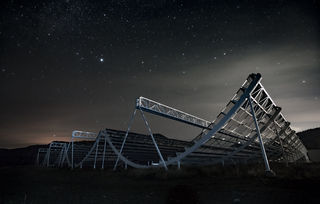 The CHIME telescope
The CHIME telescope
The Canadian Hydrogen Intensity Mapping Experiment is currently collecting data from its
site near Penticton, BC, Canada, with the goal of measuring the imprints of primordial sound
waves in the cosmic distribution of neutral hydrogen. My contributions include
co-leadership of CHIME's first cross-correlation measurement with the eBOSS survey
(paper link),
co-corresponding-authorship of the telescope overview paper
(paper link),
and co-chairing CHIME's pipeline/infrastructure working group.
Website
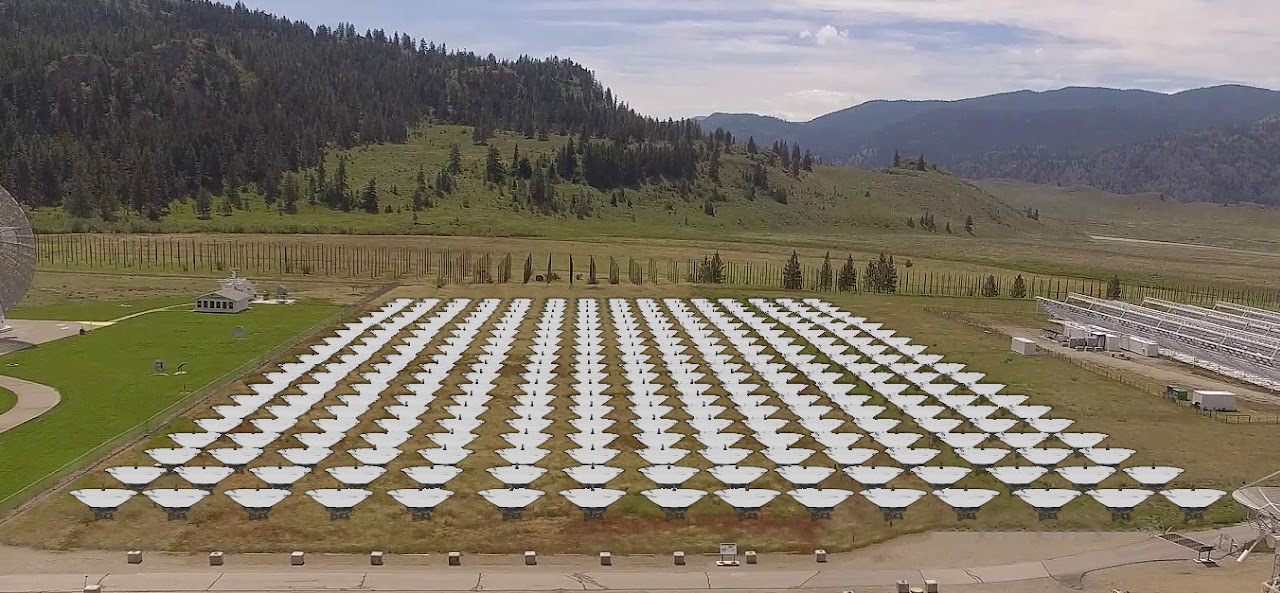 The CHORD observatory
The CHORD observatory
The Canadian Hydrogen Observatory and Radio-transient Detector is currently under construction
right next door to CHIME, and promises better sensitivity, better control of observational
systematics, and a wider frequency band. I am involved in planning for intensity mapping
measurements and spectral-line searches with CHORD.
Website
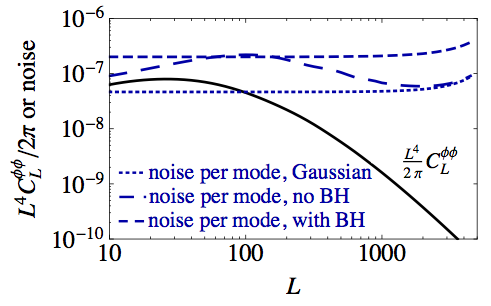 Lensing of line intensity maps
Lensing of line intensity maps
Techniques developed for measuring lensing of cosmic microwave background maps can be adapted for
line intensity maps (including, but not limited to, 21cm emission from neutral hydrogen).
However, one must be careful to account for the nonlinear, non-Gaussian nature of these maps.
Paper link
Cosmological Perturbation Theory
At very large distances, we have a robust theoretical description of the statistics of density fluctuations in the universe, as traced by luminous objects such as galaxies. As we examine smaller and smaller distances, this description begins to break down as clustering gets stronger. Cosmological simulations are a helpful tool for investigating this regime, but there is also a range of distances at which the deviations from the ong-distance description are small enough that they can be treated as perturbations, and systematically accounted for using perturbation theory. This is most usefully phrased using the language of effective field theory, borrowed from particle physics, and this language has allowed for a number of advances in the robustness of these predictions.
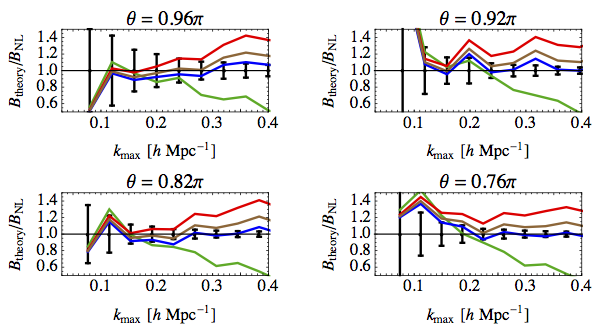 Computation of 2- and 3-point statistics
Computation of 2- and 3-point statistics
Effective field theory techniques can be used to compute clustering statistics
(the so-called matter power spectrum and bispectrum) in a self-consistent and systematic way.
Paper links: 1
2
3
4
5
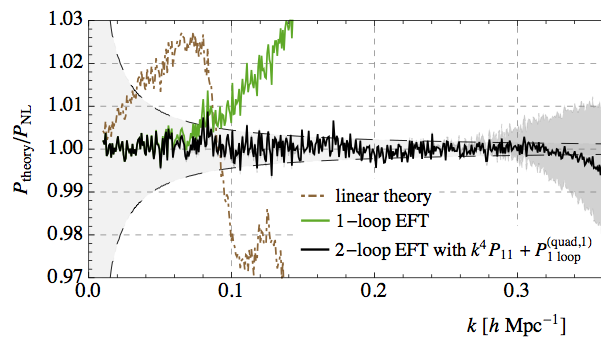 Precision comparison with simulations
Precision comparison with simulations
This approach to cosmological perturbation theory yields impressive results when compared with large simulations
of gravitational clustering.
Paper link
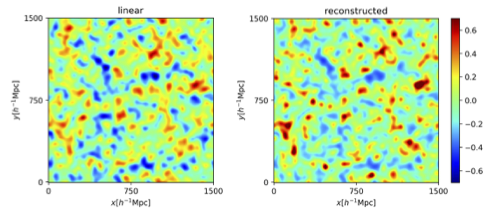 Large-scale density reconstruction
Large-scale density reconstruction
Perturbation theory describes couplings between large-scale and small-scale Fourier modes of the cosmic density
field, and these couplings can be exploited to reconstruct large-scale modes from their effects on the statistics
of the small-scale modes. However, the relationship between galaxy and matter clustering must be carefully accounted for.
Paper link
Baryonic Effects in Large-Scale Structure
The clustering of galaxies, and matter in general, is not only determined by gravitational forces at large distances, but is influenced by astrophysical processes such as gas cooling, star formation, and energy injection by supernovae and the surroundings of supermassive black holes. These so-called "baryonic" effects need to be understood to make the most use of clustering measurements that will be made in the near future.
 Baryonic effects on CMB lensing
Baryonic effects on CMB lensing
Upcoming measurements of gravitational lensing of the cosmic microwave background will be used
for a variety of purposes, but their interpretation can be contaminated by the influence of baryons.
A range for the size of this contamination can be estimated from simulations, and these simulations can
also be used to develop and test several different strategies for mitigating this effect.
Paper links: 1
2
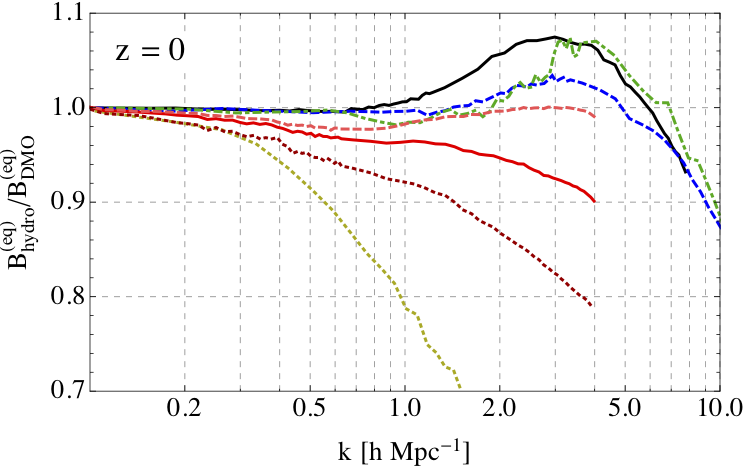 Baryonic effects on matter 3-point statistics
Baryonic effects on matter 3-point statistics
These effects on 3-point statistics have not been investigated as extensively as for 2-point statistics,
but 3-point correlation function measurements could provide a new pathway to constraining
simulation-based models for these effects, or testing the consistency of different modelling approaches.
Paper link
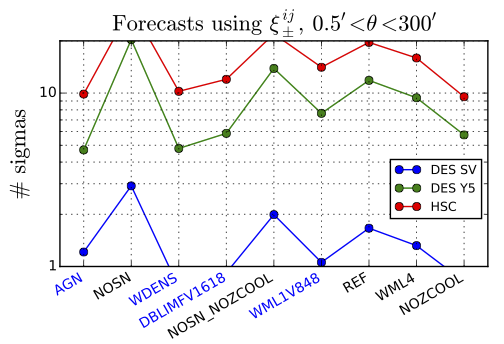 Baryonic effects on cosmic shear
Baryonic effects on cosmic shear
The lensing distortions of observed galaxy shapes are affected by these effects, and
this is often seen as a nuisance that obscures useful cosmological information.
However, one can also use lensing to constrain models for these effects, and obtain
interesting constraints even from near-term galaxy surveys.
Paper link
Cosmic Microwave Background
The CMB has been the workhorse of modern cosmology, providing unparalleled information about the overall properties of the universe. However, there is still a large amount of untapped information that future CMB surveys will measure, and even current data can be used in new, novel ways.
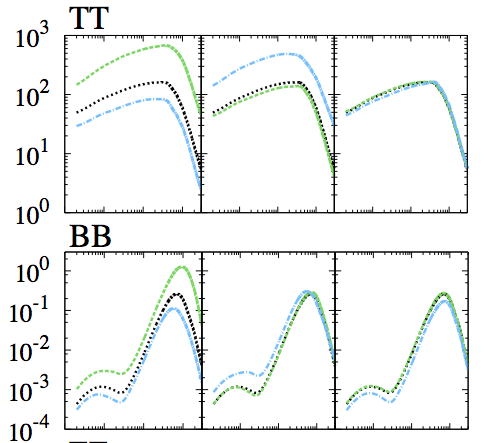 Cosmic strings in the CMB
Cosmic strings in the CMB
Anticipated constraints on the average tension of cosmic strings will be weakened if other properties of the strings, such as their mean velocity and "wiggliness" are left free in the modeling. Predictions that explore this full parameter space can be rather computationally expensive, but an efficient code that interpolates between the results of full evaluations can greatly speed up the parameter estimation process.
Paper link
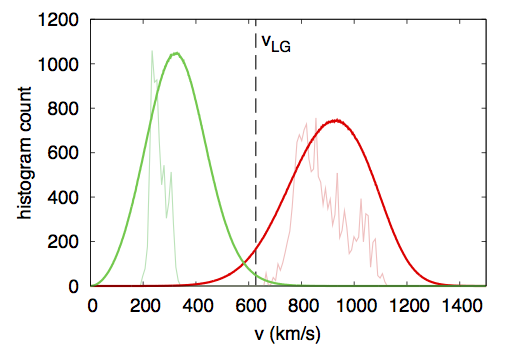 Inhomogeneous cosmology
Inhomogeneous cosmology
It has been proposed that dark energy can be replaced by a large, underdense void as an explanation for the recent acceleration of the cosmic expansion. Such an explanation would lead to a large CMB dipole, unless we are located very close to the void center. Comparison with the observed CMB dipole yields a tuning problem for void models of this type.
Paper link
Template design by Andreas Viklund